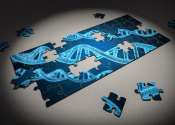Glycogen is a molecule that serves as the secondary long-term energy storage in animal and fungal cells, with the primary energy stores being held in adipose tissue. Glycogen is made primarily by the liver and the muscles, but can also be made by glycogenesis within the brain and stomach.
Glycogen is the analogue of starch, a glucose polymer in plants, and is sometimes referred to as animal starch, having a similar structure to amylopectin but more extensively branched and compact than starch. Glycogen is a polymer of α(1→4) glycosidic bonds linked, with α(1→6)-linked branches. Glycogen is found in the form of granules in the cytosol/cytoplasm in many cell types, and plays an important role in the glucose cycle. Glycogen forms an energy reserve that can be quickly mobilized to meet a sudden need for glucose, but one that is less compact than the energy reserves of triglycerides (lipids).
In the liver hepatocytes, glycogen can compose up to eight percent of the fresh weight (100–120 g in an adult) soon after a meal. Only the glycogen stored in the liver can be made accessible to other organs. In the muscles, glycogen is found in a low concentration (one to two percent of the muscle mass). However, the amount of glycogen stored in the body—especially within the muscles, liver, and red blood cells—mostly depends on physical training, basal metabolic rate, and eating habits such as intermittent fasting. Small amounts of glycogen are found in the kidneys, and even smaller amounts in certain glial cells in the brain and white blood cells. The uterus also stores glycogen during pregnancy to nourish the embryo.









